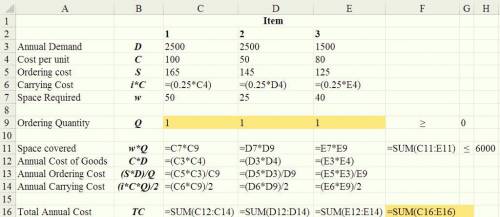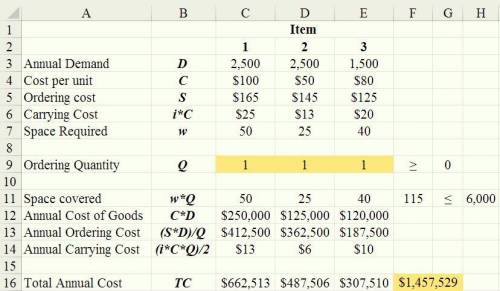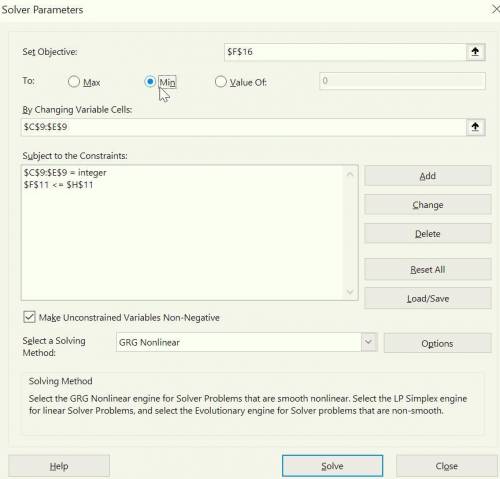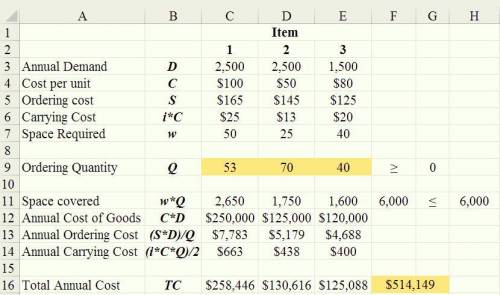
Business, 05.05.2020 23:06 marendt2014
The economic order quantity (EOQ) model is a classical model used for controlling inventory and satisfying demand. Costs included in the model are holding cost per unit, ordering cost, and the cost of goods ordered. The assumptions for that model are that only a single item is considered, that the entire quantity ordered arrives at one time, that the demand for the item is constant over time, and that no shortages are allowed.
Suppose we relax the first assumption and allow for multiple items that are independent except for a restriction on the amount of space available to store the products. The following model describes this situation:
Let
Dj = annual demand for item j
Cj = unit cost of item j
Sj = cost per order placed for item j
i = inventory carrying charge as a percentage of the cost per unit
wj = space required for item j
W = the maximum amount of space available for all goods
N = number of items
The decision variables are Qj, the amount of item j to order. The model is:
Minimize
s. t.
;
In the objective function, the first term is the annual cost of goods, the second is the annual ordering cost (Dj/Qj is the number of orders), and the last term is the annual inventory holding cost (Qj/2 is the average amount of the inventory).
Set up and solve a nonlinear optimization model for the following data. Enter "0" if your answer is zero.
Item 1 Item 2 Item 3
Annual Demand 2,500 2,500 1,500
Item Cost ($) 150 100 130
Order Cost ($) 200 160 150
Space Required (sq. feet) 75 50 65
W = $6,500
i = 0.45
Min + + + + + +
s. t
× Q1 + × Q2 + × Q3
Q1
Q2
Q3
If required, round your answer to three decimals.
Q1 =
Q2 =
Q3 =
If required, round your answer to the nearest dollar.
Total Cost = $

Answers: 3


Other questions on the subject: Business

Business, 22.06.2019 01:30, bigsmokedagangsta
Iam trying to get more members on my blog. how do i do that?
Answers: 2

Business, 22.06.2019 03:30, jadahilbun01
Instructions: use the following information to construct the 2000 balance sheet and income statement for carolina business machines. round all numbers to the nearest whole dollar. all numbers are in thousands of dollars. be sure to read the whole problem before you jump in and get started. at the end of 1999 the firm had $43,000 in gross fixed assets. in 2000 they purchased an additional $14,000 of fixed asset equipment. accumulated depreciation at the end of 1999 was $21,000. the depreciation expense in 2000 is $4,620. at the end of 2000 the firm had $3,000 in cash and $3,000 in accounts payable. in 2000 the firm extended a total of $9,000 in credit to a number of their customers in the form of accounts receivable. the firm generated $60,000 in sales revenue in 2000. their cost of goods sold was 60 percent of sales. they also incurred salaries and wages expense of $10,000. to date the firm has $1,000 in accrued salaries and wages. they borrowed $10,000 from their local bank to finance the $15,000 in inventory they now have on hand. the firm also has $7,120 invested in marketable securities. the firm currently has $20,000 in long-term debt outstanding and paid $2,000 in interest on their outstanding debt. over the firm's life, shareholders have put up $30,000. eighty percent of the shareholder's funds are in the form of retained earnings. the par value per share of carolina business machines stock is
Answers: 3

You know the right answer?
The economic order quantity (EOQ) model is a classical model used for controlling inventory and sati...
Questions in other subjects:




Chemistry, 18.04.2021 07:10

English, 18.04.2021 07:10


Law, 18.04.2021 07:10

Mathematics, 18.04.2021 07:10

Mathematics, 18.04.2021 07:10

English, 18.04.2021 07:10







